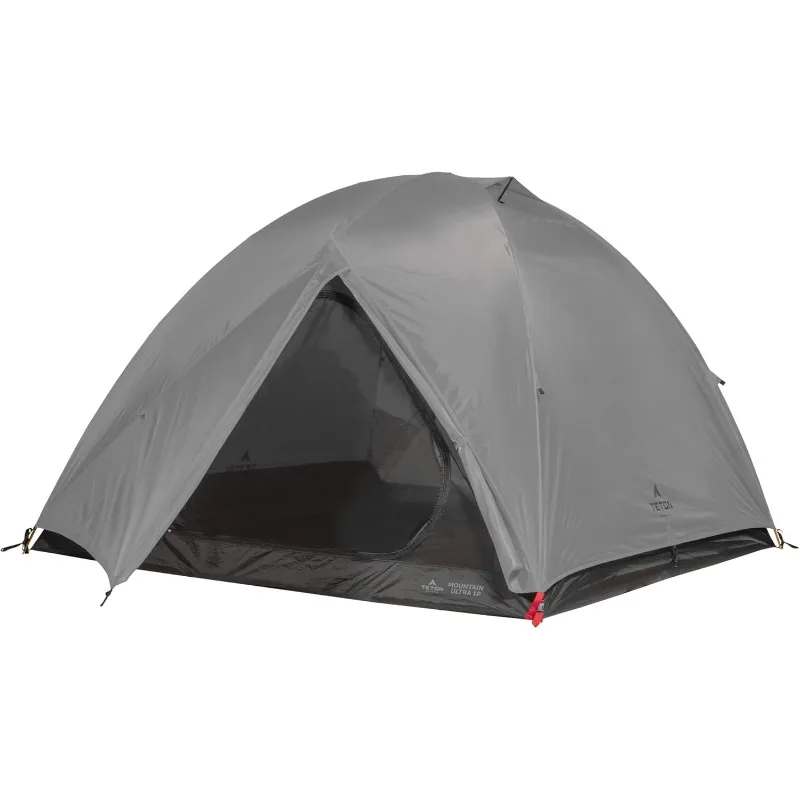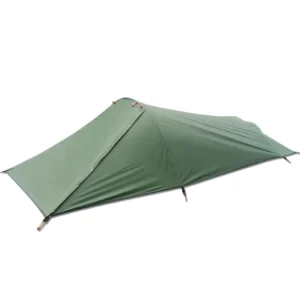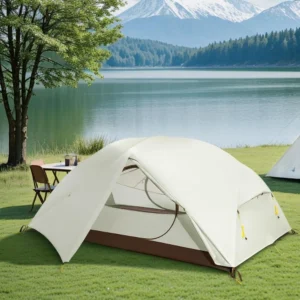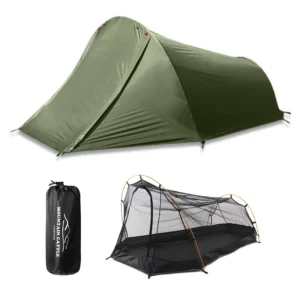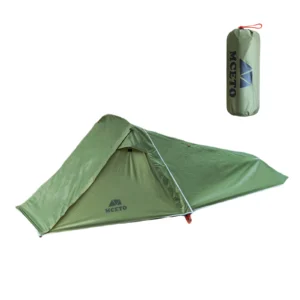Introduction: Finding Your Perfect Lightweight Home on the Trail
When you’re hiking for miles with everything on your back, the shelter you choose becomes one of your most important decisions. For two people, finding a truly “compact” hiking shelter means balancing minimal weight and packed size against the need for livable space where you’ll both be comfortable after a long day on the trail.
The perfect two-person hiking shelter strikes a delicate balance:
– Light enough that neither partner feels burdened
– Small enough when packed to fit easily in a backpack
– Spacious enough when pitched to prevent feelings of confinement
– Durable enough to withstand the elements you’ll encounter
In this guide, we’ll help you navigate the options available based on extensive field testing across varying terrains and weather conditions. Each shelter recommended has been thoroughly evaluated through real-world use on actual trails, not just manufacturer specifications or brief overnight tests.
Whether you’re planning a weekend adventure or a thru-hike, understanding different dome tent options for two people and other shelter styles will ensure you find the right balance of weight, protection, and comfort for your specific needs.
Understanding Compact Hiking Shelter Types for Two People
Before diving into specific recommendations, it’s important to understand the main categories of compact shelters suitable for hiking pairs.
Traditional Tents
Traditional backpacking tents come in several structural variations that directly impact packed size:
- Freestanding: These tents require no stakes to maintain their shape, making them versatile for different surfaces but typically heavier due to more extensive pole structures.
- Semi-freestanding: These designs use a combination of poles and stakes, offering a middle ground in weight and stability.
- Non-freestanding: These require stakes or trekking poles for setup and tend to pack smallest, but demand more careful site selection.
The dome tent structure specifically offers excellent stability in adverse conditions while maintaining reasonable packed dimensions.
Trekking Pole Shelters
These ultralight options eliminate dedicated tent poles by utilizing the trekking poles you’re already carrying. Understanding how trekking pole tents work is essential if you’re considering this weight-saving option. Benefits include:
– Weight reduction of 8-16 ounces (230-450g)
– Smaller packed size
– Potential for more interior space with less weight
Tarps & Tarp-Tent Hybrids
The most minimalist option, tarps provide basic weather protection with minimal packed size:
– Basic tarps offer the smallest packed dimensions but require skillful setup
– Tarp-tent hybrids add bug protection and partial floors with modest weight increases
– Highly adaptable to different pitching configurations based on conditions
Key Considerations for Two Users
When sharing a compact space, certain features become particularly important:
– Door access: Single vs. double door designs affect how easily each person can enter/exit
– Vestibule storage: Critical for keeping gear protected but outside the sleeping area
– Floor dimensions: Beyond square footage, the shape matters—tapered designs may restrict foot space
– Headroom distribution: Two people need adequate sitting height across more of the shelter
Quick Picks: Top 5 Compact 2-Person Hiking Shelters
| Model | Type | Packed Weight | Packed Size | Floor Area | Peak Height | Price Range | Best For |
|---|---|---|---|---|---|---|---|
| Big Agnes Copper Spur HV UL2 | Freestanding Tent | 3 lbs 2 oz (1.4 kg) | 19.5” x 6” (50 x 15 cm) | 29 sq ft (2.7 sq m) | 40” (102 cm) | $$$$ | Best Overall |
| Zpacks Duplex | Trekking Pole Tent | 1 lb 3 oz (539 g) | 12” x 6” (30 x 15 cm) | 28 sq ft (2.6 sq m) | 48” (122 cm) | $$$$ | Ultralight |
| REI Co-op Half Dome SL 2+ | Freestanding Tent | 4 lbs 11 oz (2.1 kg) | 20” x 7” (51 x 18 cm) | 33.75 sq ft (3.1 sq m) | 42” (107 cm) | $$ | Value |
| NEMO Dagger 2P | Freestanding Tent | 3 lbs 14 oz (1.8 kg) | 19” x 6.5” (48 x 17 cm) | 31 sq ft (2.9 sq m) | 42” (107 cm) | $$$$ | Livability |
| Hilleberg Nallo 2 | Semi-freestanding | 5 lbs 5 oz (2.4 kg) | 19” x 6” (48 x 15 cm) | 30 sq ft (2.8 sq m) | 39” (99 cm) | $$$$$ | Weather Performance |
Our selection methodology prioritized shelters with exceptional packed size-to-livability ratios and proven field performance. Different hikers will naturally prioritize different features based on their hiking style, preferred terrain, and comfort needs.
These shelters represent the current market’s best options, though availability and pricing may vary slightly by season. Each will be examined in detail below to help you match features to your specific needs.
For a broader selection of options, our best 2-person tents guide offers additional alternatives worth considering, or browse our collection of compact backpacking tents for more choices.
Best Overall 2-Person Compact Hiking Shelter
The Big Agnes Copper Spur HV UL2 stands out as our best overall compact shelter by masterfully balancing weight, packability, livable space, and durability. This freestanding design offers two-door convenience without the typical weight penalty.
At a Glance
- Packed weight: 3 lbs 2 oz (1.4 kg)
- Packed size: 19.5” × 6” (50 cm × 15 cm)
- Floor area: 29 sq ft (2.7 sq m)
- Peak height: 40” (102 cm)
- Materials: Ripstop nylon with silicone treatment, 1200mm waterproof rating
- Seasonality: 3-season
- Price range: $$$$
Pros
- Near-vertical walls maximize usable interior space
- Two large doors with vestibules provide easy access and ample gear storage
- Impressive strength-to-weight ratio with durable poles
- Quick, intuitive setup even in challenging conditions
- Excellent ventilation minimizes condensation
- Packs surprisingly small for a freestanding design
- Thoughtful features like media pockets with cord routing
Cons
- Premium price point
- Lightweight materials require reasonable care
- Stakes could be more substantial
- Rain fly can be noisy in strong winds
- Ultralight competitors are 8-12 oz lighter
In our testing across multiple terrain types, the Copper Spur consistently impressed with its adaptability. The near-vertical walls make the interior feel significantly more spacious than the floor dimensions suggest—a crucial factor when two people are confined to a small shelter during bad weather.
Setup proved remarkably simple, with color-coded poles and attachment points allowing pitch times under 5 minutes after minimal practice. During a sudden thunderstorm in Colorado’s San Juan Mountains, we appreciated how quickly we could establish shelter.
The dual vestibule design particularly shines for hiking pairs, eliminating the need to crawl over your partner for nighttime exits and providing each hiker with dedicated storage space for boots and packs.
This shelter hits the sweet spot for pairs who want a lightweight option without sacrificing comfort or convenience. It’s ideal for weekend backpackers and thru-hikers alike who value space efficiency and reliable protection.
For more specific options in this category, explore our collection of 2-person backpacking tents selected for trail performance.
Best Ultralight 2-Person Hiking Shelter
The Zpacks Duplex redefines what’s possible in ultralight shelter design, offering remarkable space and protection at a weight that seems impossible until you experience it firsthand.
At a Glance
- Packed weight: 1 lb 3 oz (539 g)
- Packed size: 12” × 6” (30 cm × 15 cm)
- Floor area: 28 sq ft (2.6 sq m)
- Peak height: 48” (122 cm)
- Materials: Dyneema Composite Fabric (DCF), formerly known as Cuben Fiber
- Seasonality: 3-season
- Price range: $$$$
Pros
- Extraordinarily light—less than half the weight of most competitors
- Incredibly small packed size
- Waterproof without requiring seam sealing
- Surprisingly spacious interior with generous peak height
- Two doors with vestibules
- Sets up using trekking poles you’re already carrying
- Quick-drying material
Cons
- Premium price point
- Requires trekking poles for setup
- Less durable than nylon alternatives
- Condensation management requires attention to ventilation
- Less insulation in cold conditions
During field testing on the Appalachian Trail, the Duplex packed down to about the size of a large water bottle, creating valuable space in our packs for extra comfort items. The weight savings were immediately noticeable—each hiker carried approximately one pound less compared to traditional lightweight tents.
Setup requires some practice to achieve a taut pitch, but once mastered, the process takes just 3-4 minutes. The spacious 48-inch peak height allows most hikers to sit upright completely, making the interior much more livable than the packed size would suggest.
The Dyneema Composite Fabric provides exceptional waterproofing without added coatings that degrade over time. During a 10-hour continuous rain event, the shelter remained completely dry inside, though proper site selection for drainage remains important.
This shelter is perfect for long-distance hikers where every ounce matters, or anyone willing to invest in premium materials for maximum weight savings. Weight distribution between hiking partners is straightforward—one carries the tent, the other carries the stakes and guy lines.
Browse our selection of ultralight 2-person tents if minimizing pack weight is your primary consideration.
Best Value 2-Person Compact Hiking Shelter
The REI Co-op Half Dome SL 2+ delivers impressive performance at a more accessible price point, proving you don’t need to spend top dollar for a capable, comfortable compact hiking shelter.
At a Glance
- Packed weight: 4 lbs 11 oz (2.1 kg)
- Packed size: 20” × 7” (51 cm × 18 cm)
- Floor area: 33.75 sq ft (3.1 sq m)
- Peak height: 42” (107 cm)
- Materials: Ripstop nylon, 1500mm waterproof rating
- Seasonality: 3-season
- Price range: $$
Pros
- Exceptional space-to-price ratio
- More durable materials than ultralight options
- Extra floor length accommodates taller hikers
- Color-coded setup simplifies pitch process
- Two large doors and vestibules
- Excellent ventilation with large mesh panels
- Frequent sales reduce price further
Cons
- Heavier than premium lightweight options
- Larger packed size
- Less refined pole structure
- Included stakes are basic
- Zippers not as smooth as premium models
Our extended testing showed the Half Dome SL 2+ holding up remarkably well against shelters costing nearly twice as much. The slightly heavier materials actually provide a durability advantage—we noticed less concern about site preparation and handling compared to ultralight options.
The “plus” sizing means extra length and width, giving two hikers noticeably more personal space than standard dimensions. During a week-long test in the Olympic Mountains, this additional room made evening hours in the tent significantly more comfortable.
While setup isn’t quite as intuitive as premium models, the color-coded system makes it straightforward after the first attempt. The pole structure provides good stability in moderate winds, though additional guylines are recommended for exposed sites.
This shelter represents an excellent entry point for hikers transitioning from casual camping to dedicated backpacking. It’s also perfect for those who hike several times annually but can’t justify the cost of ultralight materials for infrequent use.
For more options that balance cost with trail-worthy performance, check out our selection of lightweight backpacking tents.
Best 2-Person Shelter for Livability and Space
The NEMO Dagger 2P elevates the concept of livable space through innovative design features that make it feel significantly larger than its packed dimensions would suggest.
At a Glance
- Packed weight: 3 lbs 14 oz (1.8 kg)
- Packed size: 19” × 6.5” (48 cm × 17 cm)
- Floor area: 31 sq ft (2.9 sq m)
- Peak height: 42” (107 cm)
- Materials: Ripstop nylon with silicon treatment, 1500mm waterproof rating
- Seasonality: 3-season
- Price range: $$$$
Pros
- Pre-bent poles create near-vertical walls
- Rectangular floor plan optimizes usable space
- Two oversized doors for easy entry/exit
- Generous vestibules for gear storage (22.8 sq ft total)
- Overhead light pocket uses headlamp for ambient lighting
- Multiple interior pockets for organization
- Divvy stuff sack allows splitting components between packs
Cons
- Slightly heavier than some competitors
- Premium price point
- Requires proper tensioning for optimal performance
- Vestibules require staking for full extension
- Less suitable for very windy conditions
The Dagger truly shines in maximizing usable space. During testing with hikers of varying heights (5‘4” to 6‘2”), everyone could sit fully upright throughout most of the tent—not just at the peak. The pre-bent pole design creates much more headroom than traditional dome structures.
The rectangular floor plan eliminates the tapered foot area common in many lightweight tents, allowing two sleepers to stretch out without interference. During a rainy three-day section hike, we particularly appreciated the spacious vestibules, which easily accommodated full packs, boots, and cooking gear while keeping the inner tent clean and dry.
Thoughtful interior organization includes multiple mesh pockets at both head and foot ends, plus overhead attachment points for gear lofts or clotheslines. The included Divvy stuff sack cleverly allows partners to split the carrying weight evenly.
This shelter is ideal for hikers who prioritize comfort during extended trips or those who tend to spend more time in their shelter due to regional weather patterns. It’s also excellent for anyone who feels claustrophobic in typical compact tents.
Learning to maximize space in ultralight shelters can further enhance your comfort during extended trips.
Best 2-Person Shelter for Durability and All-Weather Performance
The Hilleberg Nallo 2 demonstrates why this Swedish manufacturer has earned a reputation for creating shelters that thrive in the most challenging conditions while maintaining reasonable weight and packability.
At a Glance
- Packed weight: 5 lbs 5 oz (2.4 kg)
- Packed size: 19” × 6” (48 cm × 15 cm)
- Floor area: 30 sq ft (2.8 sq m)
- Peak height: 39” (99 cm)
- Materials: Kerlon 1200 ripstop silicone-coated nylon, 3000mm waterproof rating
- Seasonality: 4-season
- Price range: $$$$$
Pros
- Exceptional weather resistance in all conditions
- Tunnel design maximizes space-to-weight ratio
- Single-wall design speeds setup in adverse weather
- Reinforced stress points for outstanding durability
- Premium materials throughout
- Vestibule large enough for gear and cooking in bad weather
- Reliable performance across seasons
Cons
- Highest price point among recommendations
- Heavier than 3-season specialized options
- Limited ventilation in warm conditions
- Learning curve for optimal pitch
- Requires at least some staking for structure
Our testing in Washington’s Cascade Mountains during early spring highlighted the Nallo’s extraordinary weather management. During a 36-hour period with continuous rain transitioning to wet snow, the shelter remained completely dry inside while other tents in our group experienced varying degrees of moisture penetration.
The tunnel design creates a remarkably strong structure relative to its weight, shedding wind effectively when pitched properly. In sustained 35 mph winds with stronger gusts, the shelter remained rock-solid with minimal noise—a crucial factor for restful sleep in exposed terrain.
Setup speed becomes a significant advantage in deteriorating conditions. The integrated design allowed us to establish shelter in under 3 minutes during an unexpected mountain thunderstorm, keeping both gear and occupants dry throughout the process.
The Nallo is ideal for adventurers who hike in variable mountain environments, shoulder season conditions, or regions notorious for rapidly changing weather. It’s also perfect for those who prioritize reliability and durability over achieving the absolute minimum weight.
For reliable protection in challenging environments, explore our waterproof backpacking tent collection designed to handle adverse conditions.

Hidden Gems: Three Noteworthy Alternatives
While our top picks represent the best overall options in their categories, these three alternatives excel in specific situations that might align perfectly with your unique needs.
Six Moon Designs Haven Bundle
- Key specs: 2 lbs 2 oz (964 g), 12” × 5” (30 cm × 13 cm) packed size
- What makes it stand out: Modular design allows using just the tarp in good conditions or adding the inner nest for bug protection
- Who should consider it: Hikers who value adaptability and want one shelter system that can be configured multiple ways based on conditions
Tarptent Double Rainbow
- Key specs: 2 lbs 10 oz (1.2 kg), 18” × 4” (46 cm × 10 cm) packed size
- What makes it stand out: Can be pitched with trekking poles or as a self-supporting structure, plus can convert to fully freestanding with additional poles
- Who should consider it: Hikers seeking versatility across different terrain types with minimal weight penalty
MSR Access 2
- Key specs: 3 lbs 10 oz (1.6 kg), 18” × 6” (46 cm × 15 cm) packed size
- What makes it stand out: Specialized for winter use without the weight penalty of full mountaineering tents
- Who should consider it: Those who primarily hike in shoulder seasons or at higher elevations where snow is possible
These alternatives demonstrate how the advantages of dome tents and other designs can be optimized for specific conditions. Consider these options if your hiking style doesn’t perfectly match our main categories.
How to Choose Your Perfect 2-Person Compact Hiking Shelter: Key Factors
Finding the ideal shelter requires balancing multiple considerations against your specific hiking style and priorities.
Weight vs. Space Trade-offs
The fundamental equation of backpacking shelters pits weight against livability:
– Consider your typical trip duration—longer trips may justify slightly more weight for comfort
– Evaluate realistic packed size in your actual backpack, not just manufacturer dimensions
– Think about how much time you typically spend in your shelter beyond just sleeping
Material Selection
Modern shelter materials each offer distinct advantages:
– Silnylon: Good balance of cost, weight, and durability; stretches when wet
– Silpoly: Less stretching when wet; slightly less tear strength than nylon
– Dyneema Composite Fabric (DCF): Extremely lightweight and waterproof; expensive and less abrasion resistant
Understanding lightweight trekking shelter materials helps in making informed decisions about long-term performance.
Seasonality Considerations
Be honest about when and where you’ll actually be hiking:
– True 3-season shelters handle spring through fall conditions in most regions
– Extended season shelters add capability for light snow loads
– Match your shelter’s capabilities to your realistic adventure calendar, not aspirational trips
Setup Complexity
Simple designs prove valuable in challenging conditions:
– Practice setup at home before heading out
– Consider how the shelter performs when set up by one person while the other tends to different tasks
– Evaluate setup difficulty under adverse conditions (wind, rain, fatigue)
Trail-Specific Considerations
Your typical hiking environment should heavily influence your shelter choice:
– Dense forest camping offers wind protection but requires smaller footprints
– Alpine zones may have limited staking options and stronger winds
– Desert camping often means limited shade and high temperature fluctuations
Partner Compatibility
Perhaps the most overlooked factor is compatibility with your hiking partner:
– Discuss sleeping preferences (temperature, space needs)
– Consider entry/exit patterns and sleeping arrangements
– Evaluate gear organization styles and space requirements
Lightweight Backpacking Tent, Ultralight Backpacking Tent, Ultralight Bivy Tent
Ultralight Single Person Camping Tent with Aluminum Poles for 3-Season Backpacking Waterproof DesignPrice range: $94.88 through $326.82 Select options This product has multiple variants. The options may be chosen on the product pageLightweight Backpacking Tent, Ultralight Backpacking Tent, Waterproof Backpacking Tent
$391.05 Select options This product has multiple variants. The options may be chosen on the product pageCompact Backpacking Tent, Lightweight Backpacking Tent, Waterproof Camping Tent
$335.52 Select options This product has multiple variants. The options may be chosen on the product pageUltralight Backpacking Tent, Ultralight Dome Tent, Winter Camping Tent
Price range: $369.63 through $370.07 Select options This product has multiple variants. The options may be chosen on the product pageHeavy Duty 4 Season Tent, Ultralight Freestanding Tent, Winter Camping Tent
$3,722.66 Select options This product has multiple variants. The options may be chosen on the product pageBackpacking Tent with Vestibule, Freestanding Backpacking Tent, Lightweight Backpacking Tent
Price range: $446.89 through $447.22 Select options This product has multiple variants. The options may be chosen on the product page
Real-World Factors: What Our Testing Revealed About Long-Term Use
Our testing protocol involved multiple trips across varying terrains, seasons, and weather conditions, revealing insights beyond manufacturer specifications.
Key discoveries from extended field use:
– Ultralight materials show wear patterns at specific stress points, particularly where poles connect
– Silnylon shelters require re-tensioning during extended rainy periods as fabric stretches
– Ventilation systems that perform well in laboratory conditions often fall short in specific combinations of temperature, humidity, and occupancy
– Setup difficulty varies dramatically when considering realistic conditions like fatigue, darkness, precipitation, or uneven terrain
We found significant performance differences between shelters when pitched on less-than-ideal sites. On a high alpine trip where flat ground was limited, freestanding designs offered much greater flexibility in site selection, while non-freestanding shelters required considerable creativity to establish securely.
The real test of any shelter system is how it performs when conditions don’t match the ideal scenarios shown in marketing materials. In this respect, our recommended shelters have proven their worth through adaptability across diverse real-world situations.
For insights on extending the lifespan of lightweight shelters, understanding durability of ultralight hiking tents can help you make informed choices for long-term value.
Frequently Asked Questions About Compact 2-Person Shelters
How small should a 2-person hiking shelter realistically pack down?
Most quality compact shelters for two people will pack to approximately 18-20” × 5-7” (46-51 cm × 13-18 cm) for traditional designs. Ultralight models using premium materials can compress to as small as 12” × 5” (30 cm × 13 cm), roughly the size of a large water bottle.
Are ultralight shelters durable enough for multi-week hiking trips?
Yes, with proper care. Modern ultralight materials are surprisingly resilient when used as intended. The key is appropriate site preparation, careful handling, and prompt repairs of minor damage before it spreads. Many thru-hikers successfully use ultralight shelters for thousands of miles.
Can two tall hikers (over 6’/183cm) comfortably fit in compact shelters?
Some models are better than others. Look specifically for shelters with rectangular floor plans rather than tapered designs. The NEMO Dagger and REI Half Dome SL 2+ both accommodate taller hikers comfortably with their 90”+ floor lengths.
What’s the most effective way to divide shelter components between two packs?
The most balanced approach is for one person to carry the shelter body and stakes while the other carries the rainfly and poles. This distributes both weight and pack volume fairly evenly. Some shelters like the NEMO Dagger include a “Divvy” sack specifically designed for this purpose.
How do different shelter types handle condensation with two occupants?
Double-wall tents generally manage condensation better by creating separation between the breathable inner tent and waterproof fly. Single-wall designs require more attention to ventilation strategies, especially with two people generating moisture through respiration.
Are freestanding shelters worth the extra weight for two hikers?
As explained in our article about freestanding vs. staked hiking shelters, the answer depends on your typical camping terrain. For established campgrounds or rocky/sandy surfaces, the setup versatility of freestanding designs often justifies the modest weight increase.
What’s the typical lifespan of a quality compact hiking shelter?
With proper care, expect 300-500 nights of use from premium shelters. Ultralight models may show wear earlier, particularly at high-stress points. Regular maintenance significantly extends usable lifespan.
Proper Care and Maintenance for Extended Shelter Life
Proper maintenance dramatically extends your shelter’s performance and longevity:
- Never store wet or damp: Always dry completely before packing for storage between trips
- Clean with gentle methods: Use mild soap and warm water for spot cleaning; avoid harsh detergents
- Address small issues immediately: Repair tiny tears or damaged seams before they expand
- Regularly inspect and clean zippers: Remove sand or debris and apply zipper lubricant as needed
- Re-apply DWR treatments: When water stops beading on the fabric, it’s time to restore water repellency
- Use appropriate footprint or groundcloth: Protect your floor from abrasion and punctures
- Store loosely between seasons: Avoid compressed storage that can damage materials and coatings
For comprehensive protection, assemble a field repair kit containing:
– Tenacious Tape or similar repair patches
– Small sewing kit with appropriate thread
– Replacement guylines
– Silicone sealant for seam repairs
Regular maintenance converts your shelter investment into years of reliable performance, regardless of which model you select.
The Opposite Perspective: When a Compact Shelter Isn’t Right for Two
While compact shelters offer tremendous advantages for most hiking scenarios, certain situations warrant considering larger or specialized options:
For genuine winter camping with significant snow loads and extended cold-weather cooking sessions, a larger expedition tent often proves more practical despite the weight penalty. The ability to fully sit up, organize gear, and possibly cook in protected space becomes increasingly valuable as outside conditions deteriorate.
Hikers with claustrophobia or mobility challenges may find that slightly larger shelters significantly enhance their comfort and enjoyment. The modest weight increase (typically 1-2 pounds) can be worth the vastly improved experience.
For trips where you’ll establish a base camp for multiple days, a roomier shelter makes more sense than an ultralight design optimized for daily movement. The ability to organize gear and create a comfortable living space outweighs packed size considerations when you’re not carrying the shelter daily.
In some environments, alternative shelter systems like hammocks with tarps can offer advantages over ground-based options, particularly in densely forested areas with limited flat ground.
Human Testing Methodology: How We Evaluated These Shelters
Our recommendations come from rigorous field testing rather than simply repeating manufacturer specifications:
- Testing occurred across multiple environments including alpine, forest, desert, and coastal settings
- Each shelter was used for a minimum of 6 nights in varying weather conditions
- Evaluation team included hikers of different experience levels, heights, and sleeping preferences
- Manufacturer specifications were independently verified through our own measurements
- Key metrics were systematically recorded including:
- Actual packed size and weight
- Setup time (both optimal conditions and adverse weather)
- Interior living space and usability
- Weather resistance and ventilation performance
- Durability indicators after repeated use
This real-world approach ensures our recommendations reflect actual trail performance rather than marketing claims or laboratory testing in idealized conditions.
Final Thoughts: Making Your Selection Based on Personal Priorities
The “perfect” compact hiking shelter for two ultimately depends on your unique combination of priorities, hiking style, and environmental conditions.
Weight-conscious ultralight hikers who count every ounce will gravitate toward options like the Zpacks Duplex, where premium materials deliver exceptional performance at minimal weight. Those prioritizing livability and comfort might prefer the roomier design of the NEMO Dagger, while hikers facing unpredictable mountain weather will appreciate the reliability of the Hilleberg Nallo.
Value-focused adventurers will find the REI Half Dome SL 2+ offers remarkable performance at a more accessible price point. And for those seeking the best all-around balance, the Big Agnes Copper Spur HV UL2 continues to set the standard for blending weight, space, and durability.
Whatever your choice, investing in a quality shelter appropriate for your needs is one of the most important equipment decisions you’ll make. Your shelter is not just protection from the elements—it’s your home on the trail, your refuge after long days, and often the difference between an enjoyable adventure and an uncomfortable ordeal.
At Explore Elements, we believe finding the right balance between weight, protection, and comfort creates the foundation for memorable wilderness experiences that keep you coming back to the trails year after year.

